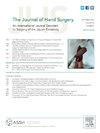上肢截肢术后精神状况。
IF 2.1
2区 医学
Q2 ORTHOPEDICS
引用次数: 0
摘要
目的:上肢截肢改变患者形态,在近端截肢的情况下,可能会降低整体功能。这些程序后的心理结果主要在单一机构的基础上进行评估。本研究旨在评估上肢截肢后人群中精神疾病的发生率。方法:查询2010年1月1日至2022年12月31日期间接受上肢截肢治疗的所有患者的TriNetX数据库。收集术前和手术日期的诊断,以确定截肢前的情况。根据国际疾病分类代码对3年的精神健康状况发生率进行了评估。采用卡方分析评估截肢水平之间的发生率。比值比用于比较与一般人群的转归率,以及与一般上肢手术人群的转归率。结果:在我们的分析期间,共有25,091例患者接受了25,415例截肢手术。该组包括23,416例经掌骨或指骨截肢,956例经前臂或腕关节脱臼,1,043例经肱骨或肩部关节脱臼。创伤性病因在所有级别中最常见。与手部截肢相比,腕部及近端截肢患者的抑郁症、一般焦虑症、精神病、情绪障碍、酒精或阿片类药物滥用、创伤后应激障碍和自杀率均有所增加。除全身性焦虑症外,所有精神疾病的发生率均高于普通人群。与接受非截肢上肢手术的患者相比,匹配分析显示,在近端指骨的所有截肢水平上,精神疾病的几率增加。结论:大约六分之一接受上肢截肢的患者在3年内出现精神疾病,与一般人群相比,发生率增加。与远端截肢较多的患者相比,近端截肢较多的患者面临更大的精神疾病负担。研究类型/证据水平:预后ii。本文章由计算机程序翻译,如有差异,请以英文原文为准。
Postoperative Psychiatric Outcomes After Upper-Extremity Amputations
Purpose
Upper-extremity amputations alter patient form and, in cases of proximal amputation, may diminish overall function. Psychological outcomes following these procedures have been evaluated primarily on a single-institution basis. This study aimed to evaluate the incidence of psychiatric conditions following upper-extremity amputation on a population-wide basis.
Methods
The TriNetX database was queried for all patients treated for upper-extremity amputations between January 1, 2010, and December 31, 2022. Preoperative and date-of-surgery diagnoses were collected to identify conditions preceding amputation. The 3-year incidence of mental health conditions was evaluated based on International Classification of Diseases codes. Chi-squared analyses were used to evaluate incidence between amputation levels. Odds ratios were used to compare outcome rates relative to the general population, as well as against that of the general, upper extremity surgical population.
Results
A total of 25,091 patients underwent 25,415 amputations during our period of analysis. This group consisted of 23,416 transmetacarpal or digital amputations, 956 transforearm or wrist disarticulations, and 1,043 transhumerus or shoulder disarticulations. Traumatic etiologies were the most common across all levels. Increases in the rate of depression, general anxiety disorder, psychosis, mood disorders, alcohol or opioid abuse, post-traumatic stress disorder, and suicidality were observed in amputations at and proximal to the wrist compared to those isolated within the hand. Except for general anxiety disorder, the incidence of all psychiatric outcomes was higher relative to the general population. Compared to patients undergoing nonamputation upper extremity surgical procedures, matched analyses revealed increased odds of psychiatric illness at all amputation levels proximal to the phalanges.
Conclusions
Approximately one in six patients who undergo an upper extremity amputation develop a psychiatric condition within 3 years, at an increased rate compared to the general population. Patients with more proximal amputations face a greater burden of psychiatric illness compared to those with more distal amputations.
Type of study/level of evidence
Prognosis IIc.
求助全文
通过发布文献求助,成功后即可免费获取论文全文。
去求助
来源期刊
CiteScore
3.20
自引率
10.50%
发文量
402
审稿时长
12 weeks
期刊介绍:
The Journal of Hand Surgery publishes original, peer-reviewed articles related to the pathophysiology, diagnosis, and treatment of diseases and conditions of the upper extremity; these include both clinical and basic science studies, along with case reports. Special features include Review Articles (including Current Concepts and The Hand Surgery Landscape), Reviews of Books and Media, and Letters to the Editor.

 求助内容:
求助内容: 应助结果提醒方式:
应助结果提醒方式:


